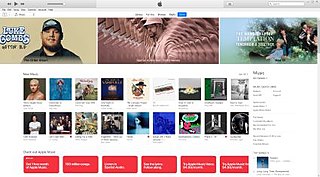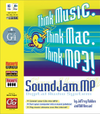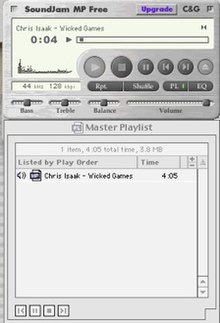
The iPod was a series of portable media players and multi-purpose mobile devices designed and marketed by Apple Inc. The first version was released on October 23, 2001, about 8+1⁄2 months after the Macintosh version of iTunes was released. Apple sold an estimated 450 million iPod products as of 2022. Apple discontinued the iPod product line on May 10, 2022. At over 20 years, the iPod brand is the oldest to be discontinued by Apple.

iTunes is a software program that acts as a media player, media library, mobile device management utility, and the client app for the iTunes Store. Developed by Apple Inc., it is used to purchase, play, download, and organize digital multimedia, on personal computers running the macOS and Windows operating systems, and can be used to rip songs from CDs, as well as play content with the use of dynamic, smart playlists. Options for sound optimizations exist, as well as ways to wirelessly share the iTunes library.

The iTunes Store is a digital media store operated by Apple Inc. It opened on April 28, 2003, as a result of Steve Jobs' push to open a digital marketplace for music. As of April 2020, iTunes offered 60 million songs, 2.2 million apps, 25,000 TV shows, and 65,000 films. When it opened, it was the only legal digital catalog of music to offer songs from all five major record labels.
FairPlay is a digital rights management (DRM) technology developed by Apple Inc. It is built into the MP4 multimedia file format as an encrypted AAC audio layer, and was used until April 2009 by the company to protect copyrighted works sold through iTunes Store, allowing only authorized devices to play the content.

GarageBand is a line of digital audio workstations developed by Apple for macOS, iPadOS, and iOS devices that allows users to create music or podcasts. GarageBand was originally released for macOS in 2004 and brought to iOS in 2011. The app’s music and podcast creation system enables users to create multiple tracks with pre-made MIDI keyboards, pre-made loops, an array of various instrumental effects, and voice recordings.
Jeffrey L. Robbin is an executive and software engineer at Apple, Inc.. He developed the SoundJam music player software, which was acquired by Apple in 2000. There, he created iTunes, and was "closely involved" with the iPod's development. In 2011, Bloomberg reported that he was leading development of an Apple television set, a device rumored in Steve Jobs's autobiography. As of 2018, he led the Apple Music product and engineering teams.

The iMac G3, originally released as the iMac, is a series of Macintosh personal computers sold by Apple Computer from 1998 to 2003. The iMac was the first major new product release for Apple under Steve Jobs, Apple's CEO and cofounder, who returned to the financially troubled company in 1996 after eleven years away. Jobs reorganized the company and simplified the product line; the iMac was designed as Apple's new consumer desktop product, a cheaper computer for average consumers that would easily connect to the internet.

Casady & Greene was a software publisher and developer active from 1988 to 2003. The company primarily released software for Macintosh, but also released software for Windows and Newton. Casady & Greene was formed in 1988 when Greene, Inc. acquired CasadyWare, a company owned by Robin Casady.

Panic Inc. is an American software and video game company based in Portland, Oregon. The company specializes in macOS and iOS applications and began publishing video games in 2016.

Music visualization or music visualisation, a feature found in electronic music visualizers and media player software, generates animated imagery based on a piece of music. The imagery is usually generated and rendered in real time and in a way synchronized with the music as it is played.

The iTunes media platform was first released by Apple in 2001 as a simple music player for Mac computers. Over time, iTunes developed into a sophisticated multimedia content manager, hardware synchronization manager and e-commerce platform. iTunes was finally discontinued for new Mac computers in 2019, but is still available and supported for Macs running older operating systems and for Windows computers to ensure updated compatibility for syncing with new releases of iOS devices.

Crystal Quest is an action game written by Patrick Buckland for the Macintosh and published by Casady & Greene in 1987. It was ported to the Apple IIGS in 1989 by Rebecca Heineman. Ports were also made to the Amiga, Game Boy, iOS, and Palm. It was the first game to support the color displays of the Macintosh II.
QuickDEX is a free form database software application first released by Casady & Greene for the classic Mac OS. An update, QuickDEX II was released and the product eventually became InfoGenie and then iData Pro. The purpose of this software is to store text data that doesn't fit into more rigid database structures. QuickDEX and its successors featured an extremely fast search, phone dialing, as well as label and envelope printing. InfoGenie and iData Pro 1.0 added the ability to have user-defined fields in a record along with the freeform text area.

Conflict Catcher is a discontinued utility software application that was written by Jeff Robbin and published by Casady & Greene for classic Mac OS. It aided Macintosh users in solving conflicts between Mac OS that could occur on startup when a large amount of extensions and control panels were installed. Later versions of Conflict Catcher included a playable Asteroids game as an easter egg in the About menu. Conflict Catcher included a printed manual written by David Pogue.
Audion was a media player developed by Panic. It was originally a commercial (shareware) program, but with the dominance of Apple's iTunes, development was halted and it was released as freeware. It was retired on November 11, 2004.
William S. Kincaid is an American computer engineer and entrepreneur notable for creating the MP3 player SoundJam MP with Jeff Robbin that was eventually bought by Apple and renamed iTunes.

Philip W. Schiller is an Apple Fellow at Apple Inc. He is a prominent figure in Apple's keynotes and has been a member of the company's executive team since Steve Jobs returned to Apple in 1997. In 2020 he became the first person in over 20 years to be appointed as an Apple Fellow, one of the company's highest-ranking positions and an honor previously bestowed on co-founder Steve Wozniak among a handful of other people.

EyeTV is a European brand of TV tuners that allow users to watch TV on various devices including computers and smartphones. The brand was introduced in 2002 by Elgato Systems and was sold to Geniatech in 2016.

The Mac is a family of personal computers designed and marketed by Apple Inc. Macs are known for their ease of use and minimalist designs, and are popular among students, creative professionals, and software engineers. The current lineup includes the MacBook Air and MacBook Pro laptops, as well as the iMac, Mac Mini, Mac Studio and Mac Pro desktops. Macs run the macOS operating system.

Music is a media player application developed for the iOS, iPadOS, tvOS, watchOS, macOS, Android, and Windows 11 operating systems by Apple Inc. It can play music files stored locally on devices, as well as stream from the iTunes Store and Apple Music.
















